
The Polyporales are an order of about 1800 species of fungi in the division Basidiomycota. The order includes some polypores as well as many corticioid fungi and a few agarics. Many species within the order are saprotrophic, most of them wood-rotters. Some genera, such as Ganoderma and Fomes, contain species that attack living tissues and then continue to degrade the wood of their dead hosts. Those of economic importance include several important pathogens of trees and a few species that cause damage by rotting structural timber. Some of the Polyporales are commercially cultivated and marketed for use as food items or in traditional Chinese medicine.
Edred John Henry Corner FRS was an English mycologist and botanist who occupied the posts of assistant director at the Singapore Botanic Gardens (1929–1946) and Professor of Tropical Botany at the University of Cambridge (1965–1973). Corner was a Fellow of Sidney Sussex College from 1959.
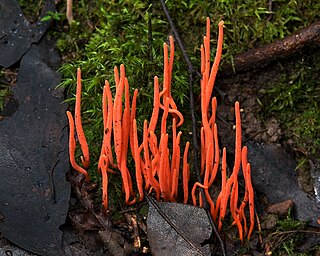
The Clavariaceae are a family of fungi in the order Agaricales. Originally the family contained most of the clavarioid fungi, but in its current sense is more restricted, albeit with a greater diversity of basidiocarp forms. Basidiocarps are variously clavarioid or agaricoid (mushroom-shaped), less commonly corticioid or hydnoid.

Paxillus involutus, also known as the brown roll-rim or the common roll-rim, is a basidiomycete fungus that is widely distributed across the Northern Hemisphere. It has been inadvertently introduced to Australia, New Zealand, South Africa, and South America, probably transported in soil with European trees. Various shades of brown in colour, the fruit body grows up to 6 cm high and has a funnel-shaped cap up to 12 cm wide with a distinctive inrolled rim and decurrent gills that may be pore-like close to the stipe. Although it has gills, it is more closely related to the pored boletes than to typical gilled mushrooms. It was first described by Pierre Bulliard in 1785, and was given its current binomial name by Elias Magnus Fries in 1838. Genetic testing suggests that Paxillus involutus may be a species complex rather than a single species.
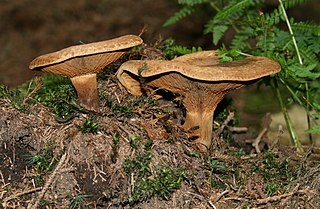
The Paxillaceae are a family of mushroom-forming fungi bearing close affinity to the boletes. Collectively, the family contains nine genera and 78 species. The type genus is Paxillus, containing fungi with decurrent gills, and Gyrodon, which has members with decurrent pores, among others. French mycologist René Maire had erected the family in 1902, placing it between the agarics and boletes and recognizing the groups' similarities with the latter group. Maire's usage of the name was later deemed to be invalid, and the genus authority is attributed to Johannes Paulus Lotsy. Molecular research confirms the relations of Gyrodon, with the decurrent-pored mushroom G. lividus, Paragyrodon, with the type species P. sphaerosporus, and Paxillus as sister groups, together lying near the base of a phylogenetic tree from which the genus Boletus arises. The name Gyrodontaceae, published by Belgian botanist Paul Heinemann in 1951, is considered synonymous with Paxillaceae.
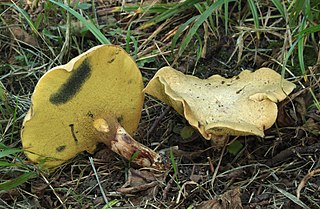
Gyrodon lividus, commonly known as the alder bolete, is a pored mushroom bearing close affinity to the genus Paxillus. Although found predominantly in Europe, where it grows in a mycorrhizal association with alder, it has also recorded from China, Japan and California. Fruit bodies are distinguished from other boletes by decurrent bright yellow pores that turn blue-grey on bruising. G. lividus mushrooms are edible.

Gyrodon is a genus of pored mushroom bearing close affinity to the genus Paxillus. Recent molecular research has confirmed this relationship of the two genera as sister taxa, together diverging as one of the most basal lineages in the Boletineae, and sister to the Boletaceae.
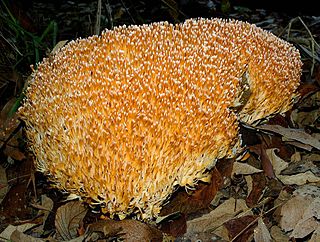
The Aphelariaceae are a family of fungi in the order Cantharellales. The family contains a small group of tropical and subtropical clavarioid fungi, but is not well characterized and has not been the subject of published research.

Lentinus is a genus of fungi in the family Polyporaceae. The genus is widely distributed, with many species found in subtropical regions.

Ramariopsis is a genus of coral fungi in the family Clavariaceae. The genus has a collectively widespread distribution and contains about 40 species. The name means 'having the appearance of Ramaria'.

Hygrophoropsis is a genus of gilled fungi in the family Hygrophoropsidaceae. It was circumscribed in 1888 to contain the type species, H. aurantiaca, a widespread fungus that, based on its appearance, has been affiliated with Cantharellus, Clitocybe, and Paxillus. Modern molecular phylogenetic analysis shows that the genus belongs to the suborder Coniophorineae of the order Boletales.

Mycena inclinata, commonly known as the clustered bonnet or the oak-stump bonnet cap, is a species of mushroom in the family Mycenaceae. The doubtfully edible mushroom has a reddish-brown bell-shaped cap up to 4.5 cm (1.8 in) in diameter. The thin stem is up to 9 cm (3.5 in) tall, whitish to yellow-brown at the top but progressively becoming reddish-brown towards the base in maturity, where they are covered by a yellowish mycelium that can be up to a third of the length of the stem. The gills are pale brown to pinkish, and the spore print is white. It is a widespread saprobic fungus, and has been found in Europe, North Africa, Asia, Australasia, and North America, where it grows in small groups or tufts on fallen logs and stumps, especially of oak. British mycologist E.J.H. Corner has described two varieties of the mushroom from Borneo. Lookalike species with which M. inclinata may be confused include M. galericulata and M. maculata.
Austrolentinus is a fungal genus in the family Polyporaceae. Segregated from the genus Lentinus, it is monotypic, containing the single species Austrolentinus tenebrosus, which was first described by E.J.H. Corner in 1981 as Panus tenebrosus. Austrolentinus was circumscribed by Norwegian mycologist Leif Ryvarden in 1991. The fungus occurs in Queensland, Solomon Islands and Papua New Guinea, and the Malay Peninsula.
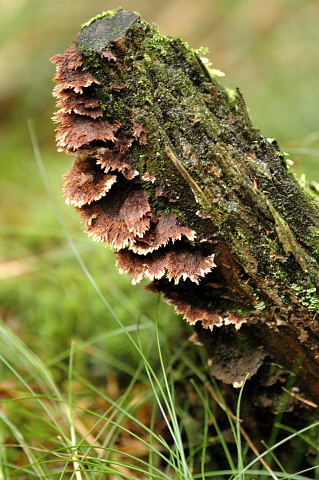
Thelephora is a genus of fungi in the family Thelephoraceae. The genus has a widespread distribution and contains about 50 species. Fruit bodies of species are leathery, usually brownish at maturity, and range in shape from coral-like tufts to having distinct caps. Almost all species in the genus are thought to be inedible, but Thelephora ganbajun is a gourmet fungus in Yunnan province of southwest China.

Boletellus dissiliens is a species of fungus in the family Boletaceae. Found in Singapore, it was originally described as Boletus dissiliens by E.J.H. Corner in 1972, and transferred to Boletellus in 1981.

Clavulina ornatipes is a species of coral fungus in the family Clavulinaceae. First described as Clavaria ornatipes by Charles Horton Peck in 1908, it was transferred to Clavulina by E.J.H. Corner in 1950.
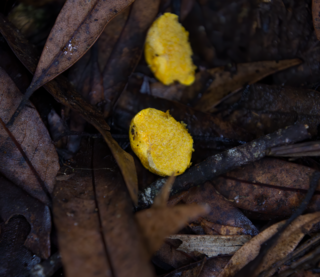
Stephanospora is a genus of truffle-like gasteroid fungi in the order Agaricales. In 2014, nine new Australasian species were described from collections previously thought to represent S. flava.
Tricholoma rhizophoreti is an agaric fungus of the genus Tricholoma. It is found in Singapore, where it fruits on mud, sticks, roots, and stumps among mangrove trees. It was described as new to science in 1994 by English mycologist E.J.H. Corner.
Tricholoma violaceibrunneum is an agaric fungus of the genus Tricholoma. Found in Peninsular Malaysia, it was described as new to science in 1994 by English mycologist E.J.H. Corner.














